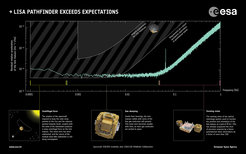LISA Pathfinder exceeds expectations
The perfect free fall in space with key contributions from Hannover researchers
The ESA satellite mission LISA Pathfinder has successfully demonstrated the technology for a gravitational wave observatory in space such as LISA.
Background information
The next steps
The scientific mission of LISA Pathfinder started on 1 March, with a review of the commissioning period presented on 7 March. The science operations will last six months, split between 90 days for the LISA Technology Package, and 90 days for the Disturbance Reduction System, an additional experiment provided by NASA's Jet Propulsion Laboratory.
The call for mission concepts for ESA's L3 mission is expected later this year, and the final decision by early 2020.
Max Planck and Leibniz Universität researchers in Hannover are leading partners in research and development of the LISA mission, which is coordinated within an international consortium.
Detailed information on the measurement results

The first two months of data show that, in the frequency range between 60 mHz and 1 Hz, LISA Pathfinder's precision is only determined by the sensing noise of the optical metrology system used to monitor the position and orientation of the test masses.
At lower frequencies between 1–60 mHz, control over the test masses is determined by gas molecules bouncing off the cubes: a small number of them remain in the vacuum surrounding them. This effect was seen getting smaller as more molecules were vented into space, and is expected to improve further in the following months.
At even lower frequencies below 1 mHz, the scientists measured a small centrifugal force acting on the cubes, due to a combination of the shape of LISA Pathfinder’s orbit and to the effect of the noise in the signal of the star trackers used to orient it.
While this centrifugal force slightly disturbs the motion of the test masses in LISA Pathfinder, it would not be an issue for a future space observatory like LISA, in which each test mass would be housed in its own spacecraft, and linked to the others over millions of kilometres via lasers. Similarly, the effects from remaining gas molecules would be far less because of the much longer mission duration.
Funding information
LPF is an ESA mission, with the European space industry under the overall integration responsibility of Airbus DS and research institutions from France, Germany, Italy, the Netherlands, Spain, Switzerland and Great Britain as well as NASA participating.
LPF is funded through the German Aerospace Center (Deutsches Zentrum für Luft- und Raumfahrt; DLR) by the Federal Ministry for Economic Affairs and Energy based on a resolution of the German Bundestag.












